This article first appeared in the spring 2005 issue of the Expert Witness, though it is based on a paper that Dr. Bruce presented at the Canadian Bar Association national conference, “Hot Topics in Litigation,” in Toronto on April 16, 2005.
In a previous article in this newsletter, “The Reliability of Statistical Evidence Concerning the Impact of Disability,” I argued that the courts should be very cautious when relying on evidence concerning the effects of disability on earnings. In this paper, I summarise some of the statistics on this factor that I consider to be reliable.
Criteria
Before a data set can be used with confidence, it must meet two criteria. First, the number of observations must be large enough that one can be certain that a representative sample has been drawn of all relevant populations. This means, first, that the sample must include individuals both with and without the disability in question; and, second, that the sample of the disabled population must be large enough that the results are not affected by accidental inclusion of unrepresentative individuals. For example, if one Canadian in a thousand has a particular disability, it might be necessary to survey one Canadian in three hundred in order to obtain a sample of sufficient size (in this case, one hundred) to ensure that a few “outliers” did not affect the statistical findings. Second, the observations must be drawn in a sufficiently random manner that the researcher can be confident that the individuals in the sample are representative of the population of interest. For example, it might not be appropriate to rely on a follow up survey of one hundred patients from a hospital that attracted an unrepresentative group of patients – unless the plaintiff was known to fall into that group.
My experience suggests that there are two sources of data that best meet these criteria: data sets constructed by national statistical agencies, such as Statistics Canada and the U.S. Bureau of Labor Statistics, and certain of the large, longitudinal studies – such as the National Longitudinal Survey or the Panel Study on Income Dynamics – that have been conducted by reputable research institutes in the United States. When employed by well-trained researchers, using appropriate statistical techniques, these data provide information on which the courts can rely. In the following sections, I summarise some of the studies that I believe meet the criteria set out above.
Spinal Cord Injuries
One of the most widely-studied groups of victims is those who have suffered from spinal cord injuries – paraplegia and quadriplegia. Fortunately, within the dozens of studies that have been conducted, there is a small set that employ large, reliably-drawn sets of data and appropriate statistical techniques. I particularly recommend three of these:
- Bruce, Christopher (2004) Assessment of Personal Injury Damages, 4th Edition, (Butterworths: Toronto), Chapter 8 (with Hao Wang).
- Krause, J. Stuart, et. al. (1999) “Employment After Spinal Cord Injury: An Analysis of Cases from the Model Spinal Cord Injury Systems” Archives of Physical Medicine and Rehabilitation 80, November, pp. 1492-1500.
- Krueger, Alan, and Douglas Kruse (1995) Labor Market Effects of Spinal Cord Injuries in the Dawn of the Computer Age, (National Bureau of Economic Research: Cambridge, MA), Working Paper 5302.
The data in my book are the most representative of the total population (both disabled and non-disabled) as they are taken from the 1990 Canadian census. However, as the census identified individuals by impact of disability rather than cause, I was forced to use “unable to walk or carry light objects” as my disability category, rather than “spinal cord injured.” The Krause et. al. and Krueger and Kruse data were less representative than mine, as the U.S. census does not provide detailed information about disabled individuals. Instead, both studies relied on concerted efforts by research groups to gather data without government assistance. This meant that, although both were able to obtain large data sets that specifically concerned individuals with spinal cord injuries, they were unable to ensure that their data were truly randomly drawn.
Nevertheless, the three studies provide compelling evidence concerning the impact of spinal cord injuries on labour market outcomes. First, because of the size and breadth of my sample, I was able to divide my data between those who had been injured before they were 20 years old and those who were injured later. This allowed me to investigate the effect that “inability to walk” had on the educational attainment of young disabled individuals. I found that non-disabled individuals were approximately twice as likely to complete a university education as were disabled; and were correspondingly much less likely to drop out of high school. (See Table 1.)

Conversely, by restricting a second sample to those who became disabled after they had completed their education, I was able to investigate the effect of “inability to walk/carry” on earnings, holding education constant. Here I found, first, that the disabled were much more likely than the non-disabled to be earning either no income or subsistence wages. Among those with high school education, for example, 26.3 percent of disabled males and 68.7 percent of disabled females earned less than $5,000 per year (in 1990), whereas the comparable figures for the non-disabled were only 4.4 percent and 20.1 percent, respectively. (See Table 2.)
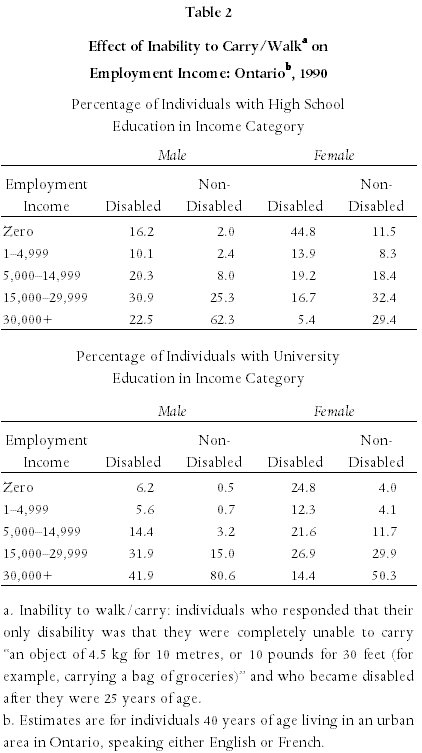
Second, there was a dramatic difference between the probabilities that the disabled and non-disabled would have earnings in the highest income category. Even after “correcting” for age, sex, educational level, province of residence and a number of other variables, I found that those who were unable to walk were less than half as likely to earn over $30,000 as were those who reported no disability.
Krause, et. al., lacking data concerning the non-disabled, could only comment on the factors that affected the probability that a spinal cord injured individual would be able to find employment. Most importantly, they found that if the individual had been employed at the time of the injury, he/she was almost four times as likely to be working after the injury as if he/she had not been so-employed; and that those spinal cord injured with a university education were three times as likely to be employed as were those with less than a high school education.
Krueger and Kruse were able to provide information concerning both employment and earnings. Perhaps their most important finding was that, even after allowing for age, sex, education, race, and marital status, victims of spinal cord injury were much less likely to be employed than were the non-disabled. Specifically, whereas approximately 75 percent of the non-disabled in their study were employed, the comparable probabilities for the sub-categories of spinal cord injury were: incomplete paraplegic, 42.2 percent, complete paraplegic, 29.5 percent, incomplete quadriplegic, 27.6 percent, and complete quadriplegic, 22.2 percent. That is, they found that the most common outcome of spinal cord injury was that the victim became competitively unemployable.
They were also able to confirm Krause’s finding that individuals with university education were three to four times more likely to be working after injury than were those with high school education or less. Whereas only 10 to 15 percent of those in the latter group were employed, 50 to 60 percent of those in the former were working post-injury.
With respect to those who did manage to obtain employment, Krueger and Kruse found that the earnings of the spinal cord injured were approximately 40 percent lower than the earnings of a matched set of non-disabled individuals. For each injured individual who had been working before his/her injury, Krueger and Kruse identified a comparable individual at the same workplace who had not been injured. They then compared the earnings of the injured and non-injured workers approximately five years after the injury occurred. Of this differential, approximately half arose because the injured parties worked fewer hours per week and half because they had lower hourly earnings.
Chronic Pain
In a recent paper, Crook et. al. ? Determinants of Occupational Disability Following a Low Back Injury: A Critical Review of the Literature,” Journal of Occupational Rehabilitation, 12 (4), December 2002, 277-295. surveyed the entire literature on the effects of chronic pain. Interestingly for the argument I made in my previous paper, they found that less than one percent of research studies they identified (19 out of 2,170) met a basic set of criteria for methodological reliability. Those studies reported that victims returned to work more quickly (following the onset of chronic pain) the younger they were, the greater was the availability of job modifications, the sooner they were referred for treatment, the less pain they had from standing and lying, and the greater was their flexibility. Males returned to work more quickly than females; and individuals with previous hospitalization or previous episodes of back pain took longer to return to work than did those without such histories.
Crook’s survey also found that females and older workers were the most likely groups not to return to work at all. Other factors making it more likely that patients would not return to work were: relatively large numbers of children at home and a lack of control over the workplace.
Finally, pain was more likely to be persistent, the older was the worker and the greater was the degree of depression.
Visually Impaired/Blind
I was able to identify only two studies of the visually impaired that provided data from large, statistically reliable sources.
- Bruce, Christopher (2004) Assessment of Personal Injury Damages, 4th Edition, (Butterworths: Toronto), Chapter 8 (with Hao Wang).
- Blackorby, Jose, and Mary Wagner, (1996), “Longitudinal Postschool Outcomes of Youth With Disabilities: Findings from the National Longitudinal Transition Study,” Exceptional Children 62 (5), 399-413.
The first of these is my own study, using Canadian census data for individuals who reported that they had difficulty, or were completely unable, to see “ordinary newsprint, (with glasses or contact lenses if usually worn).” The Blackorby and Wagner study is based on a survey of over 8,000 students who had been enrolled in special education classes at high schools across the United States and who had been interviewed between three and five years after completing secondary school. Although this group included individuals with other disabilities, it also included a substantial portion who reported “visual impairment.”
The main findings from my research are reported in Tables 3 and 4. There it is seen that although those with a seeing disability are only slightly less likely to complete advanced education than are the non-disabled, the former are much more likely to be found in the lower portion of the income distribution than are the latter.
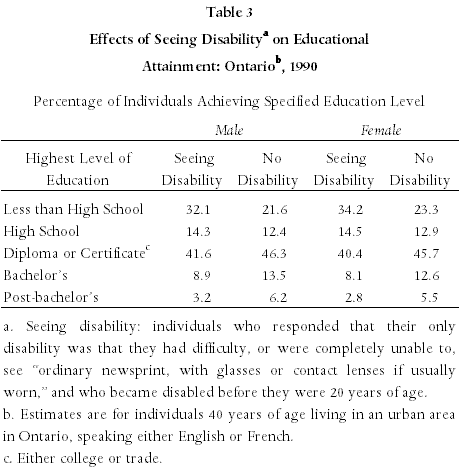
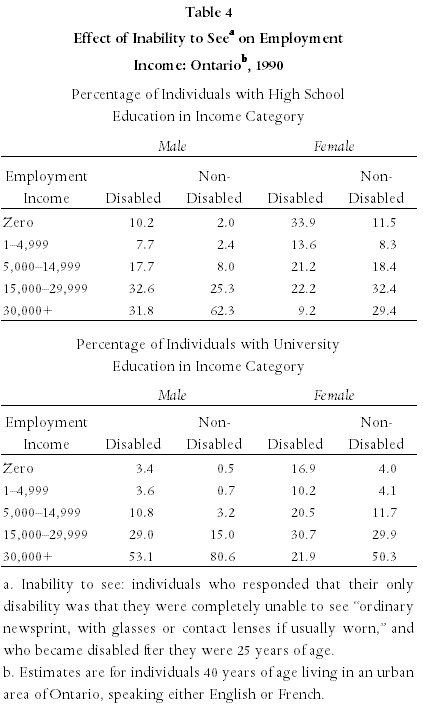
These findings were confirmed in large part by Blackorby and Wagner. They found, for example, that 57 percent of visually impaired students had attended some form of postsecondary school, only slightly less than the 68 percent of non-disabled students. Nevertheless, they found that only 29.4 percent of the visually impaired were competitively employed – less than half of the 69 percent figure for the non-disabled.
Hearing Impaired/Deaf
The two most reliable sources of information about the hearing impaired are the same as for the visually impaired:
- Bruce, Christopher (2004) Assessment of Personal Injury Damages, 4th Edition, (Butterworths: Toronto), Chapter 8 (with Hao Wang).
- Blackorby, Jose, and Mary Wagner, (1996), “Longitudinal Postschool Outcomes of Youth With Disabilities: Findings from the National Longitudinal Transition Study,” Exceptional Children 62 (5), 399-413.
The main findings from my research are reported in Tables 5 and 6. As with the visually impaired, it is seen that those with a hearing disability are only slightly less likely to complete advanced education than are the non-disabled. The impact of hearing disabilities on income are much less, however, than is the impact of visual disabilities.
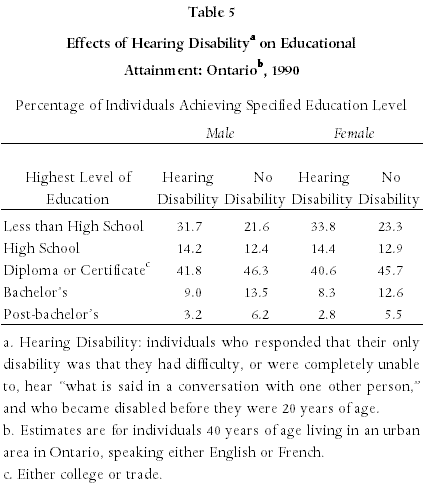
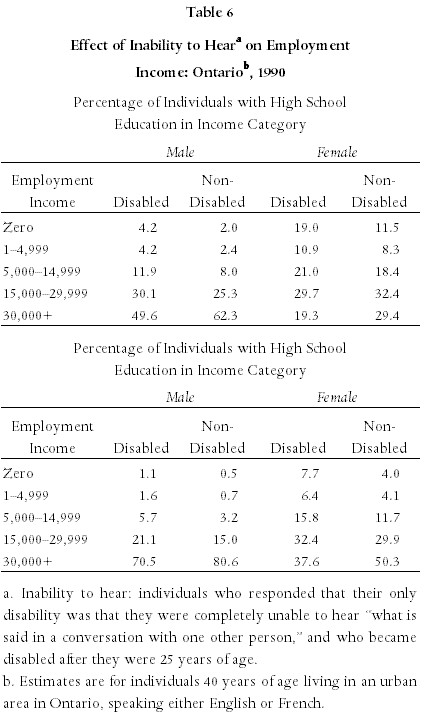
Again, these findings were confirmed in large part by Blackorby and Wagner. They found, for example, that 60 percent of hearing impaired students had attended some form of postsecondary school, only slightly less than the 68 percent of non-disabled students (and slightly more than the 57 percent of visually impaired). Similarly, they found that only 43.5 percent of the hearing impaired were competitively employed – almost 50 percent more than among the visually impaired.
Brain Injury
Two studies of the effects of brain injury appear to be based on large, representative samples. They are:
- Dikmen, S. et al. (1994). “Employment Following Traumatic Head Injuries,” Archives of Neurology, 51 (2), 177-186.
- Roberts, A.H. (1970) Severe Accidental Head Injury: An Assessment of Long-Term Prognosis (London: Macmillan)
Both studies provide data concerning the probability of returning to work, given various measures of brain damage that are commonly available from medical reports. (See Tables 7 and 8.) As would be expected, the more severe is the injury, the lower is the probability that the individual will return to work. Also, the Roberts study found that workers were less likely to return to work, the older they were.
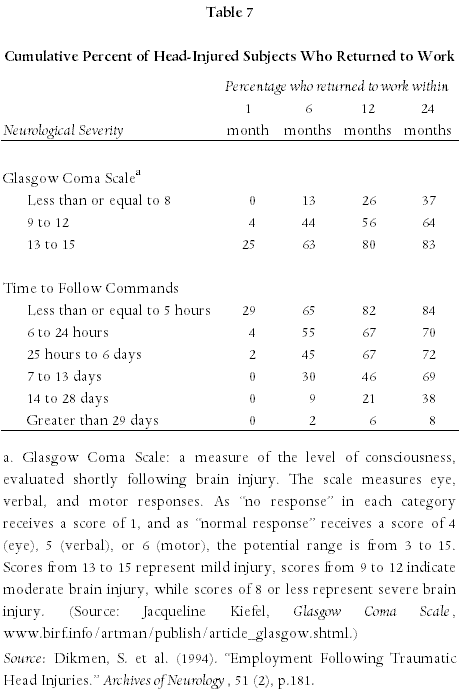
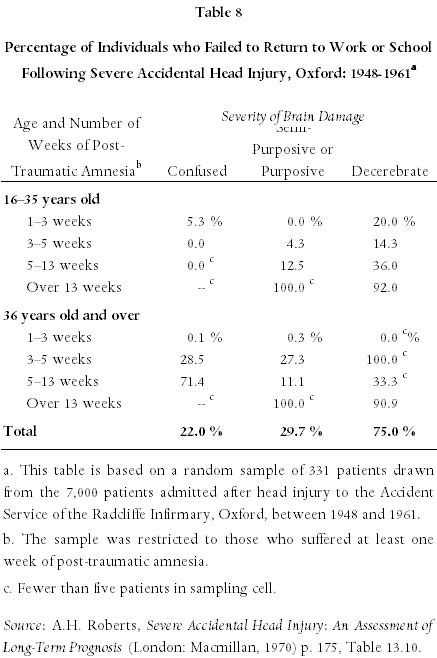
Discussion
In my experience, most medical/psychological evidence concerning the impact of disabilities on education, employment, and earnings takes two forms. First, the expert offers an opinion concerning the possibility that the plaintiff will be able to return to competitive employment. Second, the expert may offer an opinion concerning the (set of) occupation(s) for which the plaintiff can re-train if he/she cannot return to his/her pre-injury occupation. Typically, in the former case, no mention is made of the probability that the plaintiff will enter competitive employment, and in the latter case, no mention is made of the possibility that the plaintiff will work fewer hours than before the accident. Furthermore, in neither case will the expert make reference to the studies that provide statistics concerning these probabilities. Yet, as I have argued here, if one is diligent, and cautious, it is possible to identify numerous studies that provide reliable information on many aspects of the disability-employment relationship.
![]()
![]()